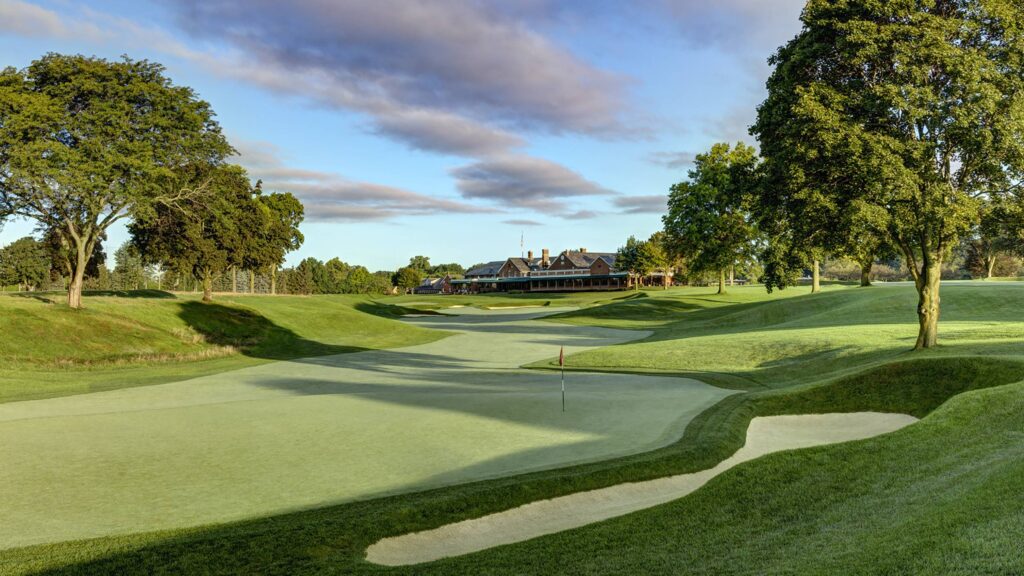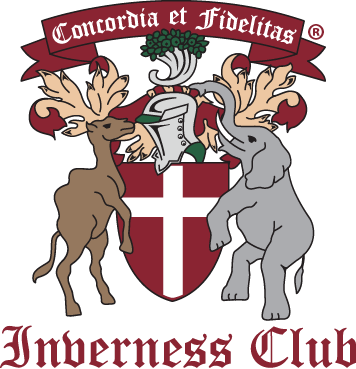Inverness’s championship course took shape during a concentrated three-year span in which Donald Ross was hired (1916), surveyed and planned an all-new 18-hole routing across the club’s rolling, glacial ground west of downtown Toledo, and saw construction through to completion in the fall of 1918; the first major test on the finished course was the 1919 Ohio Open, followed by the 1920 U.S. Open.
Ross’s commission is documented in club histories that date his hiring specifically to 1916, with the “championship course” completed by late 1918 and in full championship use by 1919.
Ross’s design intent for Inverness can be inferred from his routing decision to thread holes up, over, and across a ravine and drainage swale that bisect the property. Contemporary histories of the site describe how the new course “made use of the club’s rolling terrain through a glacially-carved ravine and drainage swale,” a choice that created the long two-shot tests that still define the middle of the round.
The club’s own chronology underscores that Ross was engaged to elevate Inverness to “championship” standard—language that appears in the club’s historical materials—and the rapid awarding of the 1920 U.S. Open immediately after the 1919 Ohio Open attests to that aim being realized on the ground.
As for later Ross involvement, architect Andrew Green has reported finding “original drawings by Ross” and “notes made ahead of the 1931 U.S. Open,” which he used to reconstruct original intentions during recent work. Those documents indicate continuing Ross oversight of his design leading into the second U.S. Open here, though the extent of any in-person 1931 alterations remains unclear in surviving records.
Subsequent non-Ross phases profoundly affected the front nine. In preparation for the 1979 U.S. Open, George and Tom Fazio were brought in; their work altered the routing and added new holes on additional land. Sources disagree on the exact count—some describe three new Fazio holes on a new parcel, while the Donald Ross Society’s club profile characterizes “four new holes” and the first major routing change from Ross.
From 2017–2018, Inverness commissioned Andrew Green to return the course to its Ross era look and strategic texture. Green’s plan, executed with McDonald & Sons, removed the Fazio holes and introduced three new holes—today’s 3 (par 3), 4 (par 4), and 5 (par 3)—built as homages to Ross’s lost Nos. 8, 7, and 13, respectively, while reshaping the par-5 8th’s green to echo the short par-4 6th of the Ross era. He also extended the 2nd green site up to a high natural point and rebuilt bunkers throughout in Ross idiom. Work began in May 2017, with the new holes opening Memorial Day weekend 2018.
The club notes it again engaged Green in 2024 for further historically informed refinements.
Unique design characteristics on this course
Ross’s surviving corridors are most evident through today’s 6th and 7th—long par-4s that (in Ross’s numbering) were originally his 4th and 5th. The Donald Ross Society has singled them out as “two of the best anywhere,” a judgment rooted in how they climb and fall across the main ravine while using elevated, exacting green platforms.
The club’s own hole notes describe No. 6 as a “slightly elevated green that sits atop a plateau” with a pronounced false front and a front-right-to-back-left canted surface—classic Inverness demands that enforce a precise ground or aerial approach.
No. 7 continues the theme from a high tee, bending gently right to an elevated, sternly sloped target with a false front that rejects indifferent second shots.
Around the turn, Ross’s preference at Inverness for small, strongly pitched putting surfaces appears in several places. At No. 9, a “small, sharply sloped green…tilted aggressively back to front” puts a premium on below-the-hole approaches.
No. 14—the start of Inverness’s finishing run of par 4s—uses a green that the club calls “small” and “a work of art,” paired with a long left bunker that sets a diagonal line for the ideal angle.
Nos. 15 and 17 continue the demanding back-to-front cants and tightly framed approach visuals that characterize Ross’s original championship test here; the club notes 17’s green as “severely sloped to the front,” punishing approaches above the hole.
Green’s 2017–18 work deliberately re-stitched these Ross traits across the altered front nine. The new 3rd (long par 3) channels the original Ross 8th by promoting a ground-feeding approach into a subtly elevated target, with flanking bunkers pinching the favored line. The new 5th models Ross’s par-3 13th, and the 4th borrows concepts from Ross’s old 7th. The rebuilt 8th green reprises strategy from Ross’s 6th, restoring the bluff-top, front-protected target that forces thoughtful lay-up and pitch choices on a reachable par 5.
Elsewhere, two holes exemplify Ross’s Inverness variety in green settings. No. 10 descends to a “sunken” green in a natural amphitheater—an unusual respite amid so many elevated targets—while No. 11 presents a low-profile surface that “flows seamlessly out of the fairway,” inviting a running approach when angles permit.
At the finish, the short par-4 18th remains a Ross-era hole occupying a natural bowl, the green “severely sloped” and encircled by amphitheater banking that has staged some of American golf’s most memorable conclusions.
Historical significance
Within Ross’s corpus, Inverness holds an outsized championship footprint. After the Ross course opened for top-level play (1919), Inverness hosted the U.S. Open in 1920, 1931, 1957, and 1979—a progression that chronicles both the design’s pedigree and its adaptability to generations of championship golf.
The 1920 Open was historic for player experience as well: Inverness opened its clubhouse to the professionals—reportedly the first private American club to do so—and the field responded by purchasing the cathedral chime clock that still greets visitors in the foyer.
The 1931 Open stretched to a record 72-hole playoff, one of the championship’s most extraordinary conclusions, reinforcing the course’s exacting nature in Ross’s corridors.
Major professional events continued: PGA Championships in 1986 (remembered for Bob Tway’s bunker hole-out at the 18th) and 1993, and more recently the 2019 U.S. Junior Amateur and the 2021 Solheim Cup. The USGA has slated the U.S. Women’s Open for June 3–6, 2027, and the U.S. Amateur for August 13–19, 2029—further validation of the course’s restored Ross character for modern elite play.
As to standing among raters, Golf Digest’s course page records Inverness as a perennial member of America’s 100 Greatest (ranked No. 58 on the 2023–24 list, and No. 62 on the 2025–26 update), reflecting improved esteem following the Green work.
Current condition & integrity
Measured against Ross’s 1916–18 work, today’s Inverness is a hybrid: the majority of routing corridors remain Ross-era, but with three Andrew Green holes standing where Fazio-era ground once lay; Green designed those three as direct homages to specific lost Ross holes and rebuilt bunkering and green perimeters across the course with archival guidance.
The Donald Ross Society summarizes the outcome plainly: the Fazio holes were “eliminated,” three new holes with Ross design cues were created, and a new 8th green and surrounds were built “similar to Ross’s sixth,” alongside a comprehensive bunker program.
Greens today reflect a mix of original Ross sites (e.g., 6, 7, 14–18) and Green’s reconstructions/relocations (e.g., the extended 2nd green to a higher natural point and the replica-in-spirit 8th). Green also pursued tree removal to reopen Ross’s intended playing widths and vistas; archival mounding behind the 7th green, visible in interwar imagery, was re-introduced.
Bunkers have been rebuilt or repositioned throughout, with hazards once again establishing the diagonal and positional questions that the club’s hole notes now describe (for example, the long left bunker that sets the preferred angle into No. 14, and the switchback-framed tee shot on No. 15).
Earlier non-Ross interventions are part of the course’s palimpsest. The Fazio project executed to prepare for the 1979 U.S. Open left a distinct imprint that never fully blended with the Ross holes; those changes have now been removed.
Arthur Hills, a club member and consulting architect for decades, refined Fazio’s work ahead of the 1986 PGA (notably at the then-par-4 5th) and subsequently led bunker renovations and yardage additions through the 1993 PGA era.
The club confirms continued collaboration with Andrew Green in 2024, indicating an ongoing commitment to steward the restored Ross character as equipment and championship demands evolve.
As it plays today, the clearest surviving examples of Ross’s work are the consecutive long par-4s at 6 and 7, whose topography, elevated targets and rejecting false fronts embody the Inverness that hosted the 1920 and 1931 U.S. Opens. The back-nine sequence at 14–18—small targets, strong front-to-back tilts, and the amphitheater finish—also reads as Ross at Inverness, with Green’s detailing stitching the early-20th-century expression back together along the altered front nine.
rosssociety.org
Sources & Notes
Inverness Club — History pages (commission year 1916; completion fall 1918; 1919 Ohio Open; 1920 U.S. Open; Green engaged 2016 and again 2024; upcoming championships context). InvernessClub.com, “History.”
Terrain and routing description (origins in 1903, Ross transformation, ravine and swale used by routing). Bradley S. Klein, The First Call, “Inverness Club: lessons from a proper course restoration,” Aug. 30, 2021.
Green’s archival sources and design program (Ross drawings; notes ahead of 1931; scope, schedule, and specific homages for new 3, 4, 5, plus new 8th green; push-back of 2nd green). Golf Course Architecture interview, Sept. 12, 2018; and GCA news item, Oct. 3, 2017.
Hole-by-hole features (false fronts/elevated greens at 6 & 7; small/tilted targets on 9, 14, 15, 17; amphitheater settings at 10 and 18). InvernessClub.com, “Golf – Course Overview” (hole pages).
Status of 6 & 7 as exemplary Ross survivors (and their original numbering as Ross 4 & 5). Donald Ross Society, “Inverness Club” profile.
Fazio changes for 1979 U.S. Open and their character (three new holes on added land; controversy) vs. DRS account of four new holes and routing change—the number is disputed in published sources. The Fried Egg, “Inverness Club review,” Sept. 6, 2024; Donald Ross Society profile.
USGA historical notes and restoration framing (2019 U.S. Junior Amateur; restoration to Ross roots; archival discoveries; list of USGA championships). USGA.org feature (July 19, 2019) and USGA press on 2029 U.S. Amateur (Nov. 17, 2021).
1920 clubhouse access and cathedral clock (player gift) (club and USGA accounts). InvernessClub.com “1920 U.S. Open,” and USGA, Dave Shedloski, “Inverness Chime Clock Ticks On,” July 26, 2011.
Future championships (2027 U.S. Women’s Open; dates and confirmation; 2029 U.S. Amateur). USGA championship sites pages.
Rater assessments (Golf Digest “America’s 100 Greatest” standing). Golf Digest course page for Inverness; club note of 2023–24 rank.
Disputed/uncertain points noted:
• Ross’s direct on-site role before the 1931 U.S. Open: Green cites Ross drawings and “notes made ahead of the 1931 U.S. Open,” evidencing design guidance from Ross, but the record does not clearly document whether Ross personally returned to execute field changes; this narrative treats post-1919 Ross involvement as probable in planning, uncertain in construction.
• Number of Fazio holes added in the 1970s: Some sources say three (on newly acquired land), while the Donald Ross Society profile states four; Green’s restoration removed the “Fazio holes” and replaced them with three Ross-inspired holes regardless of the exact 1979 count.


